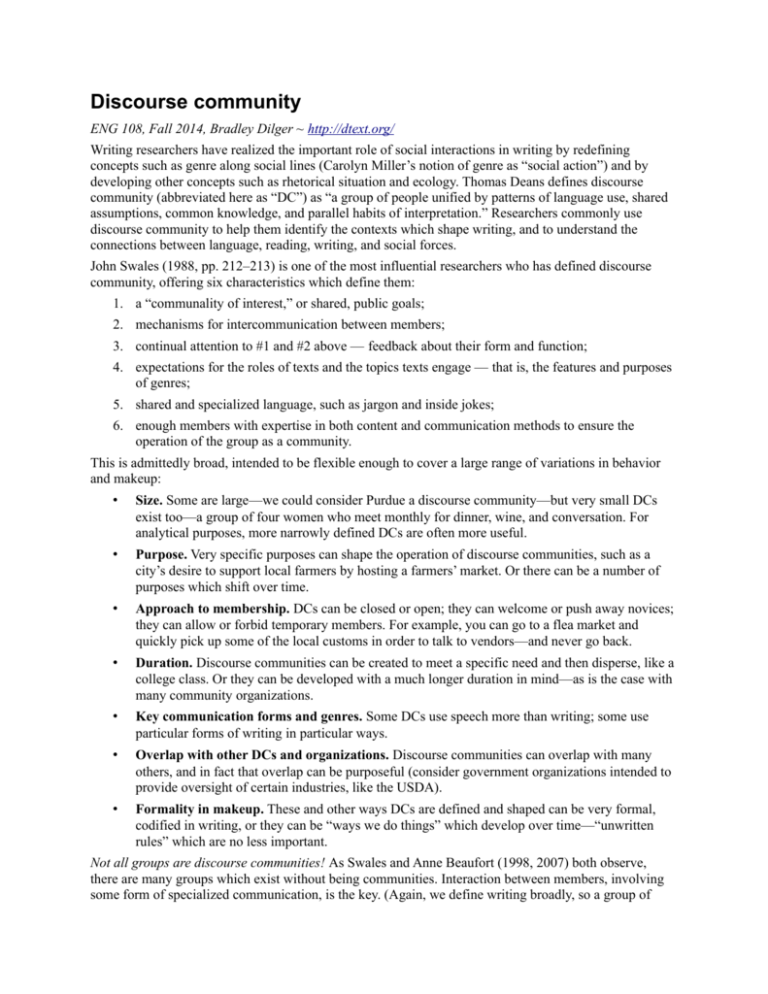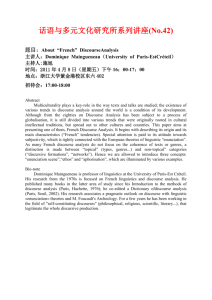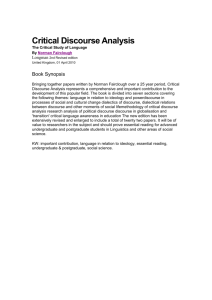Discourse community
advertisement

Discourse community ENG 108, Fall 2014, Bradley Dilger ~ http://dtext.org/ Writing researchers have realized the important role of social interactions in writing by redefining concepts such as genre along social lines (Carolyn Miller’s notion of genre as “social action”) and by developing other concepts such as rhetorical situation and ecology. Thomas Deans defines discourse community (abbreviated here as “DC”) as “a group of people unified by patterns of language use, shared assumptions, common knowledge, and parallel habits of interpretation.” Researchers commonly use discourse community to help them identify the contexts which shape writing, and to understand the connections between language, reading, writing, and social forces. John Swales (1988, pp. 212–213) is one of the most influential researchers who has defined discourse community, offering six characteristics which define them: 1. a “communality of interest,” or shared, public goals; 2. mechanisms for intercommunication between members; 3. continual attention to #1 and #2 above — feedback about their form and function; 4. expectations for the roles of texts and the topics texts engage — that is, the features and purposes of genres; 5. shared and specialized language, such as jargon and inside jokes; 6. enough members with expertise in both content and communication methods to ensure the operation of the group as a community. This is admittedly broad, intended to be flexible enough to cover a large range of variations in behavior and makeup: • Size. Some are large—we could consider Purdue a discourse community—but very small DCs exist too—a group of four women who meet monthly for dinner, wine, and conversation. For analytical purposes, more narrowly defined DCs are often more useful. • Purpose. Very specific purposes can shape the operation of discourse communities, such as a city’s desire to support local farmers by hosting a farmers’ market. Or there can be a number of purposes which shift over time. • Approach to membership. DCs can be closed or open; they can welcome or push away novices; they can allow or forbid temporary members. For example, you can go to a flea market and quickly pick up some of the local customs in order to talk to vendors—and never go back. • Duration. Discourse communities can be created to meet a specific need and then disperse, like a college class. Or they can be developed with a much longer duration in mind—as is the case with many community organizations. • Key communication forms and genres. Some DCs use speech more than writing; some use particular forms of writing in particular ways. • Overlap with other DCs and organizations. Discourse communities can overlap with many others, and in fact that overlap can be purposeful (consider government organizations intended to provide oversight of certain industries, like the USDA). • Formality in makeup. These and other ways DCs are defined and shaped can be very formal, codified in writing, or they can be “ways we do things” which develop over time—“unwritten rules” which are no less important. Not all groups are discourse communities! As Swales and Anne Beaufort (1998, 2007) both observe, there are many groups which exist without being communities. Interaction between members, involving some form of specialized communication, is the key. (Again, we define writing broadly, so a group of World of Warcraft players certainly qualifies. Even if they aren’t writing formally, they certainly have shared goals and values, and communicate a lot when they are playing.) Beaufort (1998) explains the heritage of the concept, and notes two issues which have been discussed by researchers (e.g. Bazerman & Prior, 2005): 1. It can be hard to draw DC boundaries. How do we tell two very similar communities apart? 2. In developing boundaries, how do we consider the tensions and disagreement which are part of any community? Don’t let these issues stop you from thinking about DCs—rather, just be aware of them. In fact, you can consider these issues as questions for discovery, like the questions from Deans noted below. Beaufort (2007) also offers a helpful framework for thinking about the writing in discourse communities. For her, communicators have to consider four things—they should be part of your analysis too. I’ve added one to make a list of five: 1. Rhetorics: Conventions for making arguments. What makes sound evidence and credible communication? What methods of persuasion are acceptable? What counts as good writing style? 2. Writing processes: How do communicators develop ideas? Do they collaborate while researching, drafting, revising, and editing? How do they conduct research? 3. Genres: What forms of writing does the community share? How are they typically used? How do they relate to other forms? How do they help the DC perform tasks? 4. Content: What is the subject matter most important to a DC? How does the DC determine what is and is not relevant? How does content knowledge impact communication? 5. Networks: How do communicators understand the connections between rhetorics, writing processes, genres, and content? Researching and documenting these things, in turn, can help you understand the function of a given DC: if you know one or more of these elements, you can use that knowledge to develop questions about what you do not understand. What questions can you ask about communication? These heuristics for analyzing discourse communities are based on Deans (2003, pp. 126–27): • What specific characteristics are shared by community members? What behaviors and attitudes are typical? How are they reflected (and codified?) in communication practices? • How is communication involved in becoming a member of the community? What in/formal initiation practices are common? How is membership signaled via reading, speaking, and writing? • What specific linguistic practices are used (speech patterns, dialects, vocabularies, shorthand, symbols, colors or images)? How do they vary with times, situations, purposes, and contexts? • What disagreements, flexibilities, and diversities shape the community’s use of communication? How does the community define and react to errors or poor quality communication? • How does the community use networked technologies to work? To engage other communities? Sources and further reading Bazerman, C. & Prior, P. (2005). Participating in emergent socio-literate worlds: Genre, disciplinarity, interdisciplinarity. In J. Green & R. Beach (Eds.), Multidisciplinary perspectives on literacy research (133–178). New York: Hampton. Beaufort, A. (2007). College writing and beyond: A new framework for university writing instruction. Logan: Utah State UP. Beaufort, A. (1998). Operationalizing the concept of discourse community: A case study of one institutional site of composing. Research in the Teaching of English, 31(4), 486–530. Deans, T. (2003). Writing and community action: A service-learning rhetoric with readings. New York: Longman. Swales, J. (1988). Discourse communities, genres and English as an international language. World Englishes, 7(2), 211–220.







